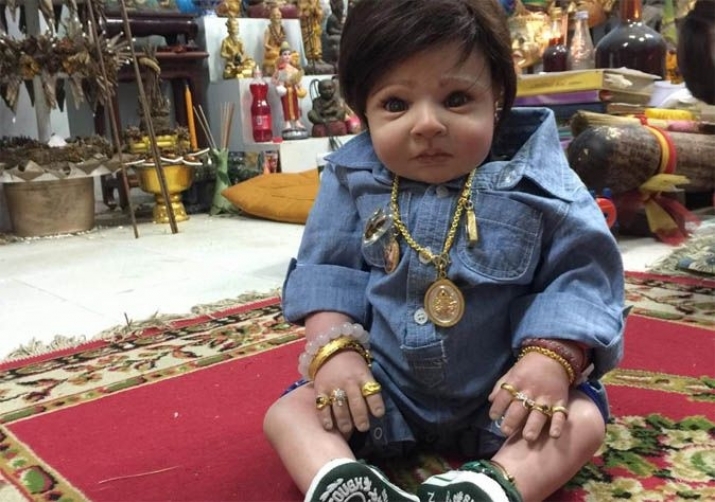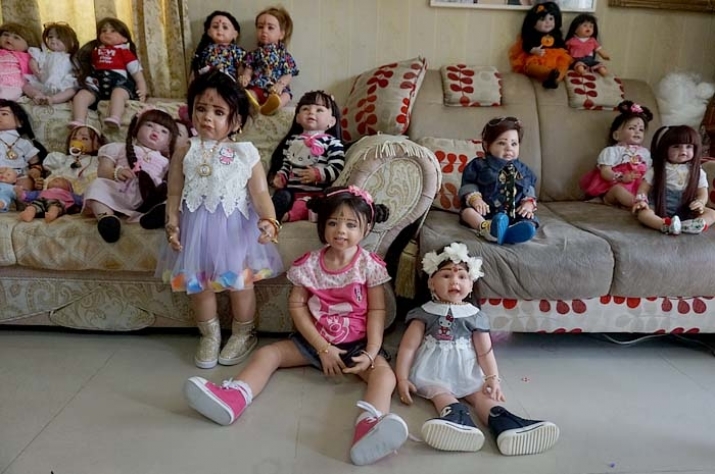FEATURES|THEMES|Commentary
Buddhistdoor View: The Perils of Spiritual Materialism
 Some Thai people believe that amulet dolls blessed by Buddhist monks can bring them material success and good fortune. From bangkok.coconuts.co
Some Thai people believe that amulet dolls blessed by Buddhist monks can bring them material success and good fortune. From bangkok.coconuts.coSpiritual materialism is perhaps one of the most powerful spiritual dangers. An easy trap to fall into, spiritual materialism operates at two basic levels: the subtle and the gross. The subtle or psychological level was articulated particularly well by Chögyam Trungpa Rinpoche in the modern classic Cutting Through Spiritual Materialism (1973). Subtle spiritual materialism denotes the practice of spirituality for the sake of ego-bolstering, when practice becomes subordinate to a fatal distraction. Materialist values are diverted from worldly ambitions such as the accumulation of wealth, goods, and status and transposed onto spiritual practice. We hear anecdotal stories from our friends, and sometimes have a few ourselves: the student who’s puffed up with pride from basking in his preceptor’s seniority, or the practitioner who can’t resist telling everyone how many repetitions of a mantra she can recite.
For now, however, we turn our attention to the gross or vulgar aspect: the cynical alliance between hard cash and spiritual legitimization. This form of spiritual materialism links the purchase of a particular service or product explicitly with the attainment of good fortune or spiritual benefit. The consumption of that product is touted as being spiritually powerful. Vulgar spiritual materialism claims that one’s desire for worldly fortune can be fulfilled via spiritual means, and that the outward signs of wealth and success are evidence of religious blessings. In the West, this simplistic theology is commonly associated with prosperity gospel (the circular reasoning that God favors the wealthy and wealth is evidence of God’s favor).
However, Buddhism is not immune to spiritual justifications for greed. The vulgar face of Buddhist spiritual materialism, like the megachurches of Rolex-touting, tithe-hungry evangelical pastors who espouse prosperity gospel theology, is much more conspicuous than the subtle spiritual materialism that Chögyam Trungpa attacked. As a qualifier, we must be careful not to condemn wholesale harmless local practices that appear to modern onlookers to be “selfish” or superstitious. There are many people in traditional Buddhist regions that, to this day, pray to Buddha images for all kinds of blessings, including material comfort and well-being. This is part and parcel of a living religion’s tensions and contradictions. Disillusioned European and American scholars in the 19th century famously dreamed of a Buddha that conformed to their cultural context—rationalist and “non-superstitious”—and condemned the real rituals of Asian Buddhists when those projections were shattered, presuming the Dharma to be degenerate.
However, the “amulet dolls” that Patheos and The Wall Street Journal have recently reported on in Thailand are a truly recent phenomenon. Simply put, this phenomenon involves people seeking Buddhist monks to bless or transfer beneficial “powers” to factory-manufactured dolls. The Thai doll business has become extremely lucrative because of the curious symbiosis between the businesses that sell the dolls and the monastic institutions that bless the dolls’ owners. The businesses gain “legitimacy” among clients and the wider public because of the perceived efficacy of the monks’ blessings and supramundane transferences. In turn, the monks stand to benefit from lucrative donations from the doll-owners, who are recommended to take their humanoid amulets to the temples by none other than the peddlers of those dolls. “To make sure a doll has a real impact, one should donate food or money to monks or offer prayers at a temple,” said Jiraphat Natthithavaranont, who sells dolls made by American companies like JC Toys Group and Madame Alexander Doll Co. at his shop, House of the God-Children.
 In Thailand, some amulet dolls can sell for well in excess of US$1,000. From bangkok.coconuts.co
In Thailand, some amulet dolls can sell for well in excess of US$1,000. From bangkok.coconuts.coThese dolls can be expensive and are often out of reach for many ordinary Thais. Jiraphat’s suite of amulet dolls ranges between US$44 and US$1,480 for premium or limited edition models. And unlike the old fetishes and black magic charms, The Wall Street Journal reports: “When some of their [Jiraphat’s dolls’] proud owners went on a day trip to the temples of Suphanburi, an hour’s ride from Bangkok on a recent Thursday, even Buddhist monks wanted to reach out and touch them.” These amulet dolls are then decorated by the monks with gold leaf and Buddhist inscriptions, just like Buddha statues.
A different but connected phenomenon of doll-related spiritual materialism has animist antecedents, indicating that these trends don’t erupt from a vacuum. For example, a Thai businesswoman called Mananya Boonmee took the tradition of kuman thong (the belief that a dead fetus is inhabited by a child’s spirit) and turned this fetal fetish into something called “life improvement accessories.” Dolls in this context are known as look thep (child gods). The child’s spirit is invited to directly possess the doll, and then the doll is pampered, fed, and dressed in lavish clothes and jewelry in the hope these haunted dolls will provide blessings and wealth in return, such as a promotion or a successful application for a job.
As with the crass and unsophisticated agenda of prosperity gospel, these amulet doll businesses don’t especially bother to conceal the emphasis on material gain and worldly success. The worry is that this is part of the attraction. The conditions that have given rise to this situation are manifold, from a confluence of ambitions regarding career and lifestyle to the traditional belief that spirits or “souls” (more accurately, “consciousnesses”) can inhabit inanimate objects and interact with the objects’ owners. Dolls are also aimed at the lower end of the market, but those with fewer socio-economic opportunities are often more vulnerable to such tactics than the middle classes. Thai anthropologist Srisakra Villibhotama told The Wall Street Journal that the amulet dolls are an example of how traditional beliefs absorb modern trends, indicating that these beliefs don’t die out but adapt to changing social, economic, and cultural realities. “Indeed,” reports The Wall Street Journal, “the faster things change, the more people turn to fortunetellers, faith healers and lucky charms to give them an edge.”
“The world is changing so quickly that people who can’t keep up feel insecure and turn to superstition,” said Srisakra. “This can boost confidence, but of course some people use amulets to show off their status, too.” In other words, the amulet doll industry is one of the “birth pains” that are occurring as older spiritual traditions (including the amulet phenomenon itself, which is an ancient practice) and materialist values endeavor to coexist and carve out a space where each can benefit from the other. Therefore, simply condemning the amulet doll craze as inappropriate or immoral is missing the wood for the trees. There is something bigger happening here that involves a structural shift in the very values of Thai society.
Vulgar spiritual materialism, no matter where it manifests, is evidence of a society struggling with itself and evolving for better or worse, with different interest groups and diverse individuals trying to stake their ground amidst relentless economic, social, and cultural change. Are certain adaptations like amulet dolls headed the wrong way? Our sense is that there are problems that need more attention, but for now, we can only bear witness and see how the trend unfolds.
See more
Buddhist Blessings for Dolls, Thailand’s new luck charms (Patheos)
Thais and Dolls: American Toys, Blessed by Buddhist Monks, Bring Good Luck (The Wall Street Journal)
All the cool kids are worshiping haunted dolls now (Coconuts Bangkok)














